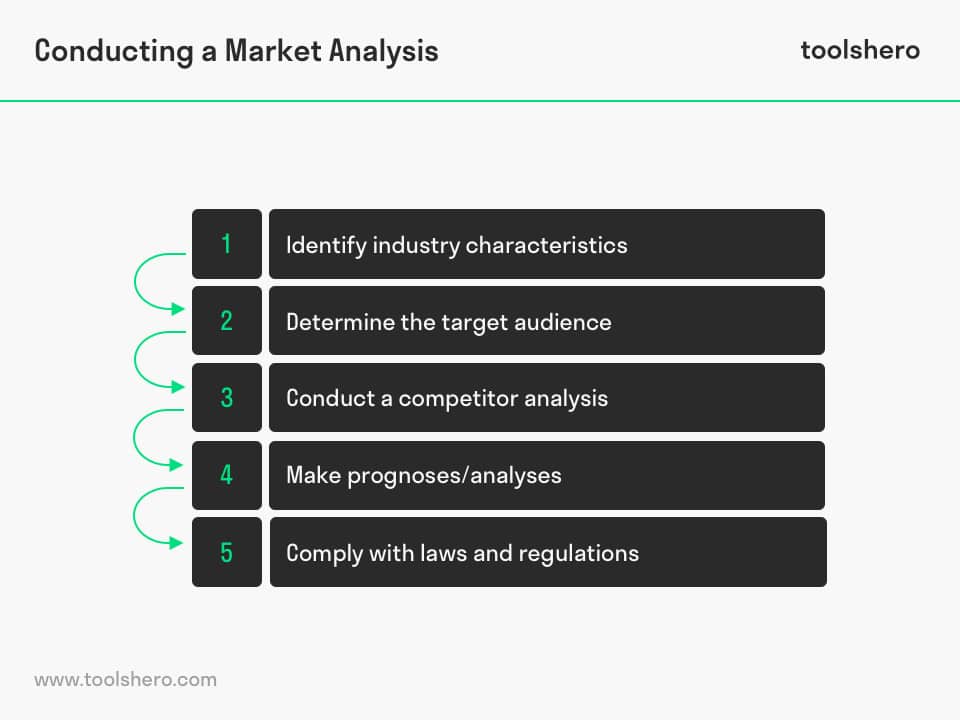Market Analysis: Steps and Examples

Market Analysis: this article provides a practical explanation of Market Analysis. Next to what it is (definition), this article also highlights how to conduct such analysis including steps and examples. After reading, you’ll understand the basics of this marketing strategy tool. Enjoy reading!
What is a Market Analysis?
The definition of Market Analysis
A Market Analysis is a quantitative or qualitative assessment of a particular market. A market can be any place where producers, distributors, or traders sell their goods/services and where consumers buy them. The term can also represent a group of buyers together; the target audience for a certain product or service.
A Market Analysis determines the appeal and dynamics in a certain market within a certain industry.
Insight into and understanding of potential customer groups is the key to success for any organisation. If businesses don’t know who their customers are, they often struggle to develop products and services that really match the needs of consumers.
Additionally, it also means that a marketing strategy cannot be employed effectively, eventually leading to the company’s downfall.
Market Analysis generally consist of a variety of elements. First, they describe the industry in which the organisation is operating in terms of the current situation and future developments.
It’s also important that an organisation identifies the different types of customers it has, with all relevant demographics and needs. Competition is another significant component of the Market Analysis.
The positioning of the competition is analysed, identifying strengths and weaknesses.
Finally, there is the cost aspect in a Market Analysis with predictions. In a way, pricing determines where an organisation positions itself in the market. Predictions about this show which segment of the market the organisation is targeting.
A Market Analysis is often one of the first steps after the creation of a business idea. It is always an element of a business plan. It is vital to determine market characteristics like market size, barriers to entry and the competitive environment.
How to conduct a Market Analysis? Steps including examples

Figure 1 – The 5 Steps of Creating a Market Analysis
Step 1: Identify industry characteristics
Whether it’s an organisation looking to expand or a startup, it’s important that the characteristics that set a certain market apart from others are identified.
The step-by-step plan frequently uses the example of a coffee roaster enthusiast who wishes to get into the coffee market on a larger scale. A business’s road to brand leadership starts with market segmentation.
Market segmentation
Depending on the product or service, a market segment can be defined using several different criteria. These can be:
- Geographic characteristics (countries, states, regions, cities, etc.)
- Demographic characteristics (sex, age, profession, income, religion, education, ethnicity, etc.)
- Psychographic characteristics (social class, ambitions, lifestyle, personality traits, etc.)
- Behavioural characteristics (loyalty, user status, product use, attitudes, etc.)
- Where does my target audience live?
Other characteristics
The first step of the Market Analysis is to get an idea of the current state of the industry and the industry’s course. Therefore, it’s important to include as many industry-related statistics as possible, such as:
- Trend
- Size
- Cycle
- Expected growth
- Supply/demand shocks
- Vulnerabilities
Step 2: Determine the target audience
By using segmentation, the coffee roaster can find out which market segments drink a lot of, and possibly the more exclusive, expensive coffee. Coffee consumption has already been extensively researched. But it is still important that the coffee roaster considers things like:
- What is the target audience of my product?
- What is the target age group of my product?
- What’s my target audience’s income?
Now that the general coffee market has been analysed, the coffee roaster will use the information to determine in which part of the market they want to start selling coffee.
For instance, the coffee roaster might be specialised in unique coffee types from Ethiopia, known for their very distinctive flavour. It’s important that the coffee roaster knows his audience well to be able to give them exactly what they’re looking for.
Needs and behaviours
The coffee roaster has to respond to the details of who the target audience is made up of, and what they want. Think about customer preferences and wishes, such as:
- Do they drink their coffee black? Or do they add milk? Sugar?
- Do they take their time to enjoy a cup, or take it to go?
Read more about qualitative and quantitative market research techniques here.
Create a user persona
A user persona is basically a fictional character representing a broader customer group. A persona is shown in a single document, containing comprehensive customer details for this type of customers. A specific products often has multiple, maybe even dozes of user personas.
Step 3: Conduct a competitor analysis
The third step when conducting a Market Analysis is investigating the competition. It’s a good idea to do that for a variety of reasons. First of all, almost no manufacturer is alone in their industry. That means the coffee roaster has to know who they’re competing against.
By conducting a competitor analysis, you discover the strengths and weaknesses of competitors. This can then be used to your advantage. Ask yourself the questions:
- Are there still consumers in the market who aren’t being served?
- What can I offer that my competitors can’t?
- How can I work more efficiently and at a lower cost than my competitors?
- Can I offer a lower price than my competitors?
When conducting competitor analyses, look at the following:
Direct competitors
These are businesses who sell very similar products or services. Potential customers of the coffee roaster are probably getting their beans from this group of competitors at the moment. Think about who is offering these products, and include them in the analysis.
Indirect competitors
Indirect competitors that offer an alternative solution to the problem you are solving. These competitors are particularly important for organisations that develop new products, services, or software.
An example of this is task management software. At first, they weren’t competing with other software programs, but with offline task managers, such as planners, notes, and to-do lists.
Market barriers
Market barriers are pitfalls that someone can step into when entering a new, specific market. Examples would be entry costs, laws and regulations, etc.
For a more comprehensive and effective analysis of a business’s external environment, use Michael Porter’s Five Forces model.
Step 4: Make prognoses/analyses
A Market Analysis isn’t just about performance overviews, past trends, and the current state of the market. Trends and future developments are also an important part of it. Predictions and prognoses are important for sales plans and potential investors.
For now, the predictions are just educated guesses. However, it is a good idea to pay close attention. Avoid prognoses that look like hockey sticks; straight and flat for a while, followed by a peak after a few years.
Market Share
It’s important that you know how much potential customers would be willing to spend for a product and how big a share of the market you could conquer. Don’t make the mistake of accepting a small market share while not exploring other segments or customer groups with your successful business.
Pricing/Margin
Explain the pricing structure, a part of the Business Model Canvas (BMC).
Analyse any discounts that you want to offer, the difference between costs and the sales price, expected price fluctuations, etc. Be realistic yet optimistic. An optimistic prognosis can be both a guideline and a target to aim for.
Step 5: Comply with laws and regulations
Are there specific government regulations for a certain market? Or could there be restrictions when it comes to import/export, for instance? Include everything that my affect the way in which you do business, and consider this in the future.
For instance, in the case of importing coffee, it’s important that a sample is lab tested as is required by the food legislation in countries all over the world.
Summary of Market Analysis
A MA is an essential part of the success of an organisation that’s involved with selling products or services. The market consists of players, such as manufacturers, logistics providers, customers, and competitors. For each of these components, there are effective best practices to do Market Analysis.
When doing this type of analysis, you must first know the industry characteristics. The market is segmented into specific groups of customers. Based on that, an organisation develops a user persona; a fictional representative of a group of customers.
Other components of an analysis on markets are the competitor analysis, and prognoses and predictions for sales figures and future market trends.
Now It’s Your Turn
What do you think? Does this Market Analysis explanation sound familiar? Have you learned enough about Market Analysis from this article to get started? What other aspects of Market Analysis would you like explanations of? Do you have any tips or additional comments?
Share your experience and knowledge in the comments box below.
More information
- Barrett, C. B. (1996). Market analysis methods: are our enriched toolkits well suited to enlivened markets?. American journal of agricultural economics, 78(3), 825-829.
- Chen, M. J. (1996). Competitor analysis and interfirm rivalry: Toward a theoretical integration. Academy of management review, 21(1), 100-134.
- McDonald, M., Christopher, M., & Bass, M. (2003). Market segmentation. In Marketing (pp. 41-65). Palgrave, London.
- Mortensen, D. T. (1986). Job search and labor market analysis. Handbook of labor economics, 2, 849-919.
How to cite this article:
Janse, B. (2019). Market Analysis. Retrieved [insert date] from Toolshero: https://www.toolshero.com/marketing/market-analysis/
Original publication date: 01/09/2019 | Last update: 01/11/2024
Add a link to this page on your website:
<a href=”https://www.toolshero.com/marketing/market-analysis/”>Toolshero: Market Analysis</a>












